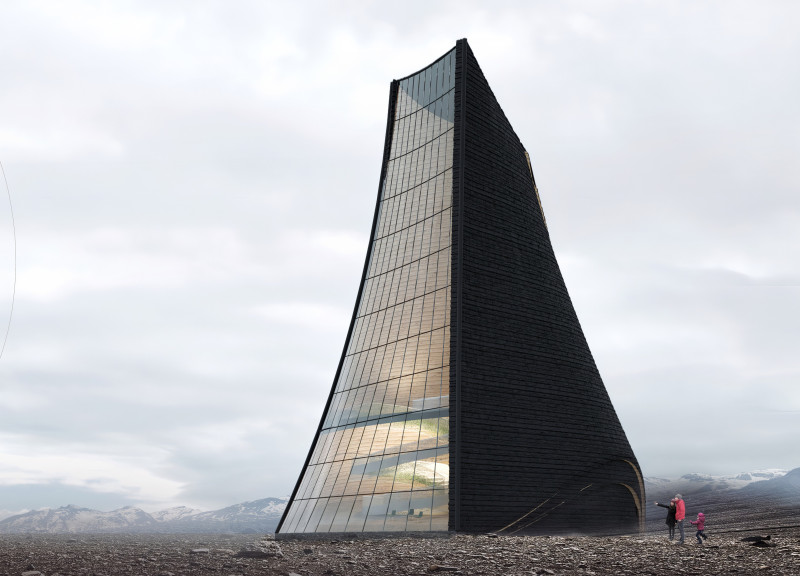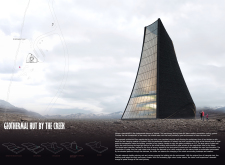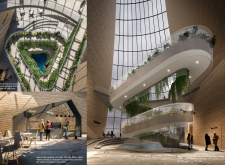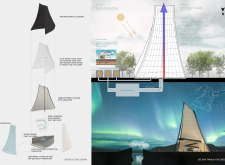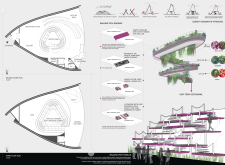Utilizing charred wooden shingles and expansive glass facades, the design creates adaptable community spaces that seamlessly integrate natural light and sustainability principles.
5 key facts about this project
01
Utilizes charred wooden shingles for enhanced durability and weather resistance.
02
Incorporates cross-laminated timber panels for structural efficiency and aesthetic warmth.
03
Features a bent A-frame design that optimizes natural light penetration.
04
Integrates rainwater harvesting systems to promote environmental sustainability.
05
Includes adaptable multifunctional spaces to accommodate varying community activities.
General keywords
The architectural project, located in [Insert Geographical Location], exemplifies a fusion of contemporary aesthetics and functional design principles. This structure serves as [insert function, e.g., a community center, residential building, office space], carefully crafted to meet the needs of its users while responding to the surrounding environment. The design not only prioritizes utility but also reflects an understanding of local cultural and environmental contexts.
The architectural layout features an open floor plan that promotes flexibility and interaction among occupants. Large windows facilitate natural light, reducing reliance on artificial lighting while enhancing the occupants' connection to the outdoors. The materials used in the construction, including concrete, glass, wood, and steel, have been thoughtfully chosen for their durability, sustainability, and visual appeal. Each element contributes to the overall integrity and functionality of the project.
Sustainability is a core principle underlying the design. The incorporation of green roofs and rainwater harvesting systems exemplifies a commitment to environmental stewardship. Additionally, the natural landscaping surrounding the building not only improves the aesthetic quality but also helps to manage stormwater effectively. This approach aligns with contemporary architectural ideas that emphasize ecological responsibility within urban settings.
This project distinguishes itself through its innovative use of space and resource management techniques. The design prioritizes adaptability, with areas that can serve multiple functions, accommodating various events and activities. The integration of smart building technologies enhances overall efficiency, allowing for real-time monitoring of energy consumption and climate control.
Attention to detail is evident in the architectural sections that illustrate the relationship between different areas within the building. The transition between private and communal spaces has been meticulously planned to ensure privacy without compromising connectivity. This nuanced design fosters a sense of community while maintaining individual comfort.
For more insights into the architectural plans, sections, and designs that underpin this project, readers are encouraged to explore the comprehensive project presentation. This will provide a deeper understanding of the architectural ideas that guided its development and illustrate the practical applications of the design principles employed.
The architectural layout features an open floor plan that promotes flexibility and interaction among occupants. Large windows facilitate natural light, reducing reliance on artificial lighting while enhancing the occupants' connection to the outdoors. The materials used in the construction, including concrete, glass, wood, and steel, have been thoughtfully chosen for their durability, sustainability, and visual appeal. Each element contributes to the overall integrity and functionality of the project.
Sustainability is a core principle underlying the design. The incorporation of green roofs and rainwater harvesting systems exemplifies a commitment to environmental stewardship. Additionally, the natural landscaping surrounding the building not only improves the aesthetic quality but also helps to manage stormwater effectively. This approach aligns with contemporary architectural ideas that emphasize ecological responsibility within urban settings.
This project distinguishes itself through its innovative use of space and resource management techniques. The design prioritizes adaptability, with areas that can serve multiple functions, accommodating various events and activities. The integration of smart building technologies enhances overall efficiency, allowing for real-time monitoring of energy consumption and climate control.
Attention to detail is evident in the architectural sections that illustrate the relationship between different areas within the building. The transition between private and communal spaces has been meticulously planned to ensure privacy without compromising connectivity. This nuanced design fosters a sense of community while maintaining individual comfort.
For more insights into the architectural plans, sections, and designs that underpin this project, readers are encouraged to explore the comprehensive project presentation. This will provide a deeper understanding of the architectural ideas that guided its development and illustrate the practical applications of the design principles employed.


